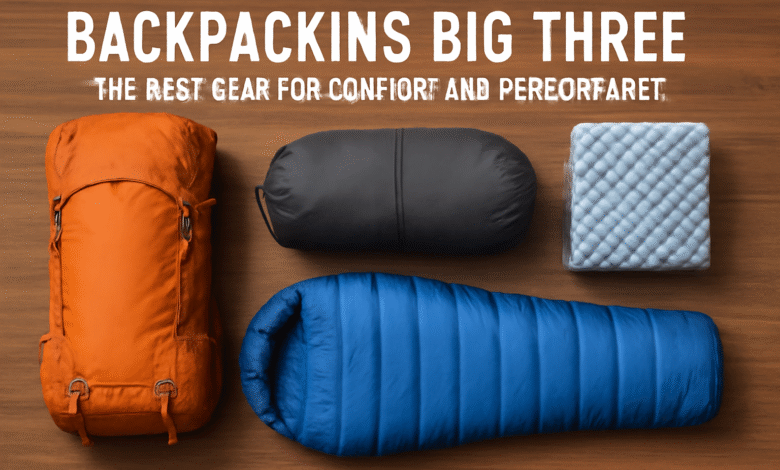Backpacking Big Three: The Best Gear for Comfort and Performance

Backpacking is one of the most rewarding outdoor activities, offering a blend of adventure, exercise, and a unique connection with nature. Whether you’re a seasoned adventurer or just starting out, the foundation of any successful backpacking trip lies in your gear. Among the most crucial elements of your backpacking kit, the “Big Three” — Shelter, Backpack, and Sleep System — play a key role in ensuring your comfort, safety, and overall performance on the trail. In this article, we’ll dive deep into what makes each of these components essential, helping you choose the right gear for your next wilderness journey.
1. Shelter: Your Home Away from Home
When you’re out in the wild, your shelter is more than just a place to rest — it’s your protection from the elements, your place of refuge, and the core of your comfort. The shelter you choose can make or break your backpacking experience.
Choosing the Right Shelter for Your Needs
The primary types of shelters for backpacking are tents, tarps, and hammocks. Each has its own set of benefits and is suitable for different environments and personal preferences.
- Tents: Tents are the most common form of shelter for backpackers. They offer protection from wind, rain, and bugs, which makes them a great choice for various weather conditions. Most backpacking tents are lightweight and compact, designed to provide a good balance between comfort and portability. When selecting a tent, consider the weight, weather resistance, and ease of setup.
- Tarps: If you’re seeking a minimalist approach and a lighter pack, a tarp might be the right choice. A tarp can be pitched in a variety of ways to provide shelter from rain, sun, and wind. However, tarps offer less protection from bugs, which is something to consider depending on the area you’ll be trekking through. They work best in dry conditions or when the weather is not too unpredictable.
- Hammocks: For those who like to sleep off the ground, hammocks are a great option. They provide a comfortable sleep system and are ideal for areas with plenty of trees. However, hammocks require the use of rain flies for protection against rain and wind, and some people might find them uncomfortable in colder conditions.
Key Features to Look for in Your Shelter
Regardless of the type of shelter you choose, there are several factors that will impact your overall experience:
- Weather Resistance: Always check the tent or tarp’s waterproof ratings, especially if you plan to hike in areas with frequent rain.
- Ventilation: Proper ventilation is crucial for comfort, especially in tents. Look for shelters with adequate mesh panels or vents to reduce condensation and promote airflow.
- Weight: A lighter shelter is always preferable when you’re hiking long distances, but make sure you balance weight with durability and functionality.
- Space: Consider how much space you’ll need. A two-person tent might be sufficient for solo hikers who want extra space, but if you’re traveling with a partner, ensure the shelter can comfortably accommodate both of you.
Shelter and Safety: A Crucial Connection
Your shelter doesn’t just protect you from the elements; it also serves as your safe haven. A solid shelter is especially important in unpredictable weather conditions or when you’re venturing into areas where wildlife is present. Whether it’s a downpour, a cold night, or a bear encounter, the right shelter ensures you’re safe and well-rested for your next day on the trail.
2. Backpack: Carrying Your Essentials with Ease
Your backpack is the vessel that carries all of your gear, and its importance cannot be overstated. A poorly fitting or uncomfortable backpack can lead to painful hikes, bruises, and fatigue. In contrast, the right pack will keep you organized, comfortable, and ready for the trail ahead.
What to Look for in a Backpack
Choosing the right backpack involves considering several factors, from size and fit to features and comfort.
- Size: Backpacks typically come in three sizes: daypacks (20-35 liters), medium-sized packs (40-60 liters), and large backpacks (65+ liters). For weekend or short trips, a 40-50 liter pack might be sufficient, while longer trips may require a larger pack to carry more gear.
- Fit: The fit of your backpack is crucial. A pack that’s too big or too small can cause discomfort, especially when carrying heavy loads. Look for a pack with adjustable straps, a hip belt, and a frame that suits your torso length and body shape. A well-fitted pack helps distribute the weight evenly across your body, minimizing fatigue.
- Comfort: Comfort is key when it comes to backpacks. Look for padded shoulder straps, a ventilated back panel, and a hip belt to alleviate pressure. The load lifter straps, which help adjust the pack’s weight distribution, are another feature to keep in mind.
- Organization: A good backpack will have multiple compartments to help keep your gear organized. This makes it easier to access items like food, first aid kits, and clothing without rummaging through your entire pack. Features such as side pockets, front mesh pockets, and hydration reservoir sleeves can also enhance convenience.
- Durability: The material of the backpack matters too. Nylon and polyester are both durable and lightweight options, but be sure to check the denier (the thickness of the fabric). The higher the denier, the more durable the fabric. Waterproofing or water-resistant coatings also add extra protection for your gear.
Why Backpack Comfort is So Important
When you’re carrying everything you need for your trip, the backpack is your best friend. The right backpack can make the difference between a smooth, enjoyable hike and a painful one. Proper weight distribution, comfort, and organization reduce the strain on your body, allowing you to move faster, farther, and more efficiently.
3. Sleep System: Resting Well on the Trail
Rest is one of the most important aspects of backpacking. After a long day of hiking, your sleep system is your sanctuary — a place to recharge your body and mind for the next adventure. The sleep system typically consists of a sleeping bag, sleeping pad, and sometimes a pillow. Each piece plays a crucial role in ensuring you get a good night’s rest.
Choosing the Right Sleeping Bag
A sleeping bag is an essential piece of gear that ensures you stay warm and comfortable throughout the night. Consider the following factors when choosing a sleeping bag:
- Temperature Rating: Sleeping bags come with temperature ratings, which indicate the lowest temperature at which the bag will keep you warm. Make sure to select a sleeping bag that aligns with the climate of your hiking destination. If you’re hiking in colder climates, you’ll need a bag rated for lower temperatures.
- Insulation Type: Sleeping bags are typically filled with either down or synthetic insulation. Down is lighter and more compressible, making it ideal for backpacking. However, synthetic insulation retains warmth even when wet, making it a better choice for humid or wet environments.
- Shape and Fit: The shape of the sleeping bag affects its warmth and comfort. Mummy bags are more efficient at trapping heat, while rectangular bags offer more room to move around. Choose a bag that suits your sleeping preferences and the climate you’ll be in.
The Importance of a Good Sleeping Pad
While a sleeping bag keeps you warm, a sleeping pad keeps you comfortable. The pad acts as a barrier between you and the cold ground, offering insulation and cushioning.
- R-Value: The R-value measures the sleeping pad’s insulating properties. A higher R-value means better insulation. If you’re camping in colder weather, look for a pad with a higher R-value.
- Thickness and Comfort: The thickness of the pad plays a role in its comfort. A thicker pad generally provides more comfort, but it also adds weight. For minimalist backpackers, inflatable sleeping pads are lightweight but can be less comfortable than thicker foam pads.
- Packability: Like your shelter and backpack, a good sleeping pad should be lightweight and packable. Look for one that can easily fit into your backpack without taking up too much space.
How to Get Quality Sleep on the Trail
To get a good night’s sleep on the trail, it’s essential to set up your sleep system properly. Choose a flat, dry, and level area for your tent or shelter. Lay down a groundsheet to protect your sleeping pad and bag from sharp objects or moisture. Additionally, make sure you’re dressed appropriately for the weather — layer your clothing to regulate your body temperature, as it’s easier to adjust layers than it is to heat up or cool down a sleeping bag.
4. Why the Backpacking Big Three Matter
The combination of your shelter, backpack, and sleep system forms the backbone of your backpacking kit. These three components work in tandem to keep you comfortable, safe, and well-prepared for your journey. When selecting your gear, always consider the weight, durability, and performance of each piece. Choosing the best gear for your needs will help ensure a smoother, more enjoyable adventure in the wilderness.
To learn more about optimizing your backpacking big three, take a deep dive into the world of gear that enhances performance and comfort in the wild.
Conclusion
The right gear can make or break your backpacking experience. By selecting the best shelter, backpack, and sleep system, you ensure a comfortable and safe journey that allows you to fully enjoy the beauty and challenges of the outdoors. Keep these elements in mind when preparing for your next adventure, and always test your gear before you head out into the wild to ensure it’s the best fit for your needs.
For more information on how to select the perfect gear for your journey, visit https://www.outdoortechlab.com/backpacking-big-3/.

